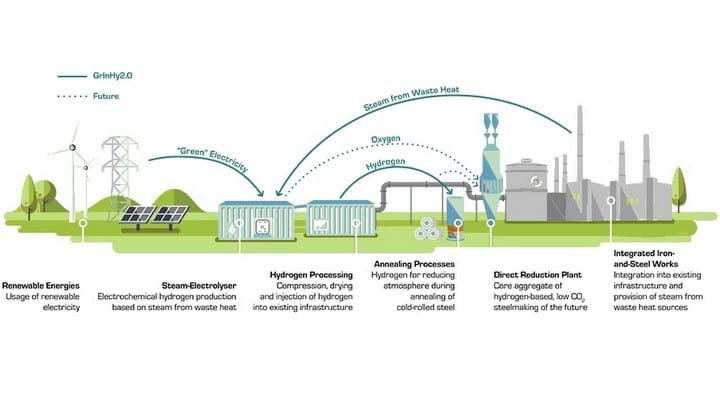Sunfire and Salzgitter to build world’s most powerful steam electrolysis plant

TECHNOLOGY company Sunfire, the Salzgitter Group, and their international partners are to build the world’s most powerful steam electrolysis plant for energy-efficient hydrogen production. Salzgitter will use the hydrogen for steelmaking.
The GrInHy2.0 project was launched in January at Salzgitter Flachstahl (SZFG), a steel subsidiary of the Salzgitter Group which will operate the plant. It follows on from the successful first stage, Green Industrial Hydrogen via steam electrolysis (GrInHy), which launched in March 2016 and concluded in February. GrInHy was a collaboration between SZFG and Sunfire.
Sunfire’s steam, or high-temperature, electrolysis will form the central element of the new project, as in the previous. In electrolysis, electricity is used to drive an otherwise non-spontaneous chemical reaction. Two electrodes and a solid oxide electrolyte will comprise the electrolyser cells. In cells, steam at 150°C will be electrochemically converted into molecular hydrogen and oxygen. This process allows electrolysis to achieve maximum electrical efficiency. Steam will be produced using waste heat from steelmaking.
The produced hydrogen will be used in annealing processes of SZFG’s integrated steelworks, replacing hydrogen produced from natural gas. Annealing is a heat treatment which is used mostly to make materials more ductile. For use in annealing the hydrogen will first be compressed at an overpressure of up to 10 bar and then dried using a pressure swing adsorption.
The high-temperature electrolyser will produce hydrogen at a rate of 200 m3/h. It is expected to have been in operation for 13,000 h by the end of 2022, producing approximately 100 t of high purity (99.98%) hydrogen.
GrInHy2.0 will have a nominal power input of 720 kW, an increase from GrInHy which had a nominal power input of 150 kW. According to Sunfire, the increase will allow the project to “extensively trial and test the integration of ‘green’ hydrogen into the steelworks processes”.
Electrical efficiency in the new project is expected to be increased as compared to the previous, from about 78% to at least 84%.
The project has been given an overall budget of €5.5m (US$6.22m).
Recent Editions
Catch up on the latest news, views and jobs from The Chemical Engineer. Below are the four latest issues. View a wider selection of the archive from within the Magazine section of this site.




